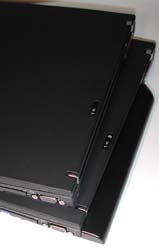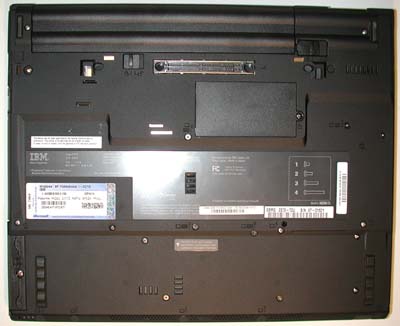Intel Centrino/Pentium-M Notebook Roundup: Dell, FIC and IBM Examined
by Matthew Witheiler on March 12, 2003 11:22 AM EST- Posted in
- Laptops
IBM ThinkPad T40 and T40p - Build, Appearance, Size (continued)
The front of the T40 is where the speakers are found. There are two speakers located here, one slightly to the left of the system's center and one slightly to the right. The bottom half of the front side, where the speakers are located, is angled down which prevents one's hands from blocking the speaker output but at the same time directs noise from the speakers directly onto the surface one is working on. On the left side of the front is the system's IR window. The screen release lever is on the right side of the front and is opened by sliding the lever to the right.
The left side of the T40 series notebooks is home to a number of the unit's ports. First up is a stack of two type-II PCMCIA slots. It amazed us to see that IBM was able to provide two PCMCIA slots on the T40 given its small size. As you can see in the picture below the two slots account for a good amount of the system's depth. Not much room to spare here.
Right next to the PCMCIA slots is the system's exhaust port. About as wide as the PCMCIA slots, the exhaust port serves as the exit point for air blown over the CPU's heatsink. The small size of the port compared to Pentium 4-M cooling solutions should give you an idea of how cool the Pentium M processor runs at. If the exhaust port is any indication, no excessive cooling solution is required. To the left of the exhaust port are two 3.5mm audio jacks, one for headphone out and one for microphone in. The exhaust port extends slightly to take up a small portion of space above the audio jacks. This portion of the cooling solution is not actually for exhaust but for air intake.
The ethernet and modem jacks are the next items on the T40's left side. Ethernet status lights are located to the right of the ethernet port (the bright light in the picture below) and indicate transmit and receive status. The modem jack is immediately to the left of the ethernet jack and comes with a small piece of plastic covering it up. The plastic is there to prevent users from jamming an RJ45 cable into the RJ11 modem jack. Only a few years ago it would have been the ethernet jack blocked up by the plastic cover but the proliferation of broadband technology has changed that.
There is an S-video out port on the left side as well as a stack of two USB 2.0 ports. The final item on the left side: a Kensington lock port.
Thanks to the plethora of ports located on the T40's left side, the back of the unit is mostly free of connections. The only two ports back here are a parallel port and the system's power port.
It is the back of the T40 that gives us a glimpse at another difference between the T40 and the T40p. As the picture below indicates, the back of the T40p extends out further than that of the T40. Why is that, you may ask. That is because the T40p comes with a new high capacity lithium-ion battery standard. Although larger, the high capacity battery reportedly offers about two and a half extra hours of battery life.
The high capacity battery pack is about 1" larger than the standard battery pack meaning that it extends a little less than 1 inch from the system's back. The battery fits the shape of the system nicely but does make the system a bit larger. We would have to wait for the battery life benchmarks before we could determine how justified the extra size is.
Like the back of the system, the right side of the T40 is fairly devoid of ports. The only port here is a VGA-out port located on the back right of the system. Next to the VGA port is the system's optical drive. The T40 comes outfitted with an 8X DVD-ROM drive or a CD-RW/DVD combo drive depending on the model selected. You may notice that the optical drive looks much smaller than the optical drives found in typical notebook computers. That is because it is. Like the FIC system, the IBM T40 notebooks use optical drives unlike any others we have seen in notebook computers. The drive is significantly smaller than previous generation optical drives, as the picture below shows.

The T40's optical solution compared to the Latitude D800 optical drive.
Click here to enlarge.
The drive is easily removable via a pull tab and is hot swapable. The bay can also be outfitted with an lithium polymer battery which reportedly extends battery life by another two hours. The picture of the right side below shows the T40 with the standard battery pack.
The bottom of the system gives access to three parts of the notebook. On the front left side in the picture below there is a screw used to release the system's hard drive. Simply release the screw and pull the drive out. In the middle of the system is an access panel used to gain access to an expansion SODIMM memory slot. In both the 256MB T40 and the 512MB T40p this expansion slot is available making for an easy memory upgrade later on. Above the memory access panel is a long connection used for IBM's docking station. The two levers around this connection are used to release the unit's battery pack.
One nice thing about the T40 is that a good number of the screws on the bottom are labeled with not only what they hold in place but how large of a screw is in that location. The guide on the right of the system indicates what number corresponds to what screw size and small pictures indicate if the screw holds in the keyboard or the case.
The IBM T40 series notebooks are true thin and light solutions. The unit measures 12.2" x 10.0" x 1.0", a perfect size in our book. Fully outfitted the unit weighs just under 5 pounds (4.9 pounds to be exact) and removing the optical drive lightens the load to 4.5 pounds. The high capacity battery does add some to the length of the system (about 11 inches at the maximum point) and a bit to the weight (putting the unit closer to 6 pounds fully configured). Even with the high capacity battery the system remains very manageable and easy to carry and use. A welcome change from the 2+", 9+ pound desktop replacement systems we are used to seeing and, in many cases, just as fast (as you will see shortly).
















3 Comments
View All Comments
builda - Thursday, February 2, 2006 - link
There appears to be a wide spread fault with the Gigabyte NB-1401 model notebook, where it reports having system disk errors or cannot find the hard disk. We have 7 of this model notebook and now 6 of them have reported the same problem. After running chkdsk to temporarily repair the errors that had been caused on the harddisk I found the problem returned the escalated to the point the harddisk could not be found. I further checked using Hitachi drive fitness testing tool which reported a cable error on each machine. Originally I returned 3 of these for repair as they were just outside the warranty period and the supplier checked with Gigabyte with the fix being to rub the cable all over with an eraser!! This worked for a short period but the problem has returned a couple of months later and has spread (like a virus) it now affects 6 out of the 7 notebooks. The supplier has just gone into administration and my next step is to approach Gigabyte who's support service has been found to be extremely unresponsive in the recent past.dbiberdorf - Tuesday, July 27, 2004 - link
I beg to differ with the reviewer. The keyboard on this unit is mediocre, and the track stick buttons are an abomination. They sit too low in the case and have too much travel. It makes my thumbs hurt after a while, and I often have to press them with a finger to get them to activate fully.The most powerful notebook in the world loses big points in my book if they built-in keyboard and pointing devices are weak. Certainly it's the case here. Dell, please figure out how to buy good keyboards for your machines!
Finally, the power adapter, while featuring convienent wrap-around cabling, is phenomenally large. My cordless phone at home is smaller. With the large profile of the machine, the adapter has to go in a side pocket of the carrying case, adding a little more bulge to your day.
visibilityunlimited - Thursday, October 30, 2003 - link
Screen resolution beyond SXGA+ would be unreadable using Windows for example while being more readable using Linux.Both the Linux text console and graphics mode X-windows-system screen drivers can be fully customized to display text at any resolution. The text characters could easily be displayed with current software at 1200dpi or more (if only the graphics processors and monitors could operate at that speed) and still retain the current character size. Text can currently be generated from vector based Type I and TrueType fonts for rasterizing at any resolution. Image scaling is a different and very easy problem.
The Windows OS is the real culprit holding back general usage of higher resolutions and typeset quality displays because of the OS being handicapped by the inertia of antique display modes. Darn. I want 3200x2400 or more!